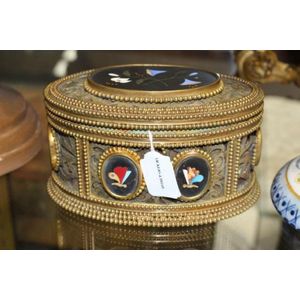French Bronze Pietra Dura Box
You must be a subscriber, and be logged in to view price and dealer details.
Subscribe Now to view actual auction price for this item
When you subscribe, you have the option of setting the currency in which to display prices to $Au, $US, $NZ or Stg.
- Pietra Dura / Florentine Mosaic - Pietre dura, also known in English as "Florentine mosaic" is a decorative art that originated in Renaissance Italy and involves the creation of intricate, multi-layered inlaid designs using a variety of different coloured stones. The name "pietre dura" is Italian for "hard stones," and refers to the use of hard, durable materials such as marble, agate, jasper, and other semiprecious stones in the creation of the designs.
The origin of pietre dura can be traced back to ancient Rome, where the technique was used to create intricate inlaid designs for mosaic floors, walls, and other architectural elements. During the Renaissance, the technique was revitalized in Italy and became particularly associated with the city of Florence. The court of the Grand Duke of Tuscany, Cosimo I de' Medici, was a major patron of pietre dura and employed many of the leading artists and craftsmen of the time to create a wide range of objects, from small items like jewelry boxes and vases to large panels and furniture.
In the 19th century, pietre dura was used to create a wide range of decorative objects, from furniture and decorative panels to small items like jewelry boxes, vases, and picture frames. During this time, the technique was particularly popular in Europe, where it was used to create elaborate pieces of furniture and other decorative objects for the wealthy and aristocratic classes.
In addition to traditional pietre dura objects like cabinets, tables, and vases, the 19th century saw the development of new forms of pietre dura, such as book covers, cigar boxes, and other small items. This was largely due to the advent of new, more affordable production techniques and materials, which allowed for the creation of pietre dura objects on a larger scale and at a lower cost. - Bronze - An alloy of copper and tin, traditionally in the proportions of about 9 parts of copper to 1 part of tin.
The discovery of bronze in Western Asia in the 4th century enabled people to create metal objects which were superior to those previoulsy possible because of its strength and hardness, and it has been used throughout the world for weapons, coins, tools, statuary and other decorative items.
It is very fluid in a molten state, and its hardness, strength when set, and non-corrosive properties makes it most suitable for casting sculpture.
This item has been included into following indexes:
- boxes, material or decoration
Visually similar items

Doulton Lambeth water filter, 36 cm high

A Sawankhalok lidded jar, c15/16th century, Thailand; the body with an indented design decorated with geometric motifs, burnt blue and white glaze crackled all over, private catalogue no. 43 affixed to the unglazed base Provenance: from the private collect

Good silver plated biscuit barrel 17 cm high approx.

Vintage brass lidded tobacco jar brass jar with embossed decoration to lid and sides, lead lined interior, and damper, height 12 cm
